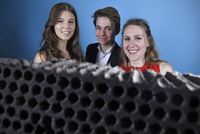Also in 2020 RST – Rostock System-Technik accompanies the Max-Planck-Institut für Plasmaphysik (IPP) within the project of the fusion experiment Wendelstein 7-X.
After the commissioning of the fusion experiment in 2015, hydrogen plasma has been generated for the first time in February 2016. By continuing its cooperation with the IPP, RST is continuously involved in paving the way for the development of alternative energy sources through nuclear fusion.
The current order is covering the design, manufacture, and delivery of gap protection grids for the baffle and wall protection elements of the plasma vessel for which a total amount of 4000 so-called double grids of different shapes are required.
Due to design reasons, baffles and wall protection elements show gaps which allow to pass parasitic thermal radiation and microwaves coming from the plasma. To avoid thermal overload of sensitive components mounted behind the baffle and wall protection elements – like cryo pumps, plasma diagnostics, cables and pipes – these gaps have to be closed using the gap protection grids. In addition, all gap protection grids have to be designed to resist eddy current forces.
The necessary cleaning and packaging for future integration in ultra-high vacuum environment took place in the in-house clean room of RST.

Wendelstein 7-X: Gap protection mesh for plasma vessel protection // Source: RST




